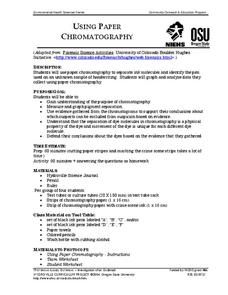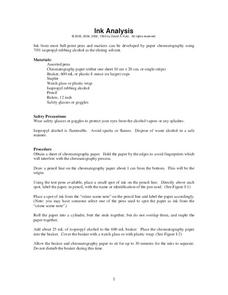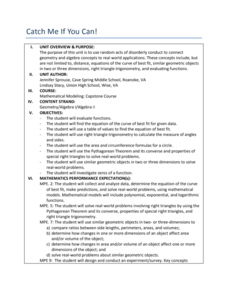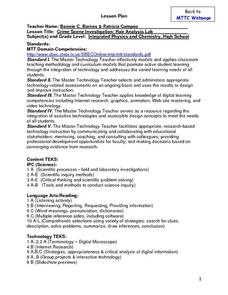Manitoba Education and Early Childhood Learning
Forensic Sciences: A Crime Scene Investigation Unit
Mr. Bergman has been murdered and we need you to solve the crime! The cross-curricular unit covers 11 different types of forensic science and includes 17 activities. Scholars perform blood type analysis, blood spatter analysis, height...
Curated OER
Bloodstain Pattern Simulations: A Physical Analysis
Students receive bloodstain pattern evidence from a crime scene. They answer a series of questions through inquiry, observation, measurement, and analysis. Pupils complete this challenge, by reconstructing the evidence through four...
Curated OER
Crime Scene Documentation
Students become forensic investigators. In this crime scene lesson, students go to the science lab which is the "scene of the crime." They collect evidence such as fingerprints, "blood" evidence, chromatography, footprints, and more.
Frederick Moleski, Ph.D.
Blood Spatter: Bloodstain Analysis Experiments
It may be gruesome but somebody's got to do it! Young forensic scientists get a feel for what the job entails as they study blood spatter in seven experimental activites. They examine how spatter can be changed by release height,...
Oregon State
Using Paper Chromatography
Through the analysis of paper chromatography to separate ink from the pen found at the crime scene, learners analyze the different stains and through calculations determine the thief.
Curated OER
Lipstick Chromatography/Ink Chromatography
Junior crime scene investigators are instructed in two different chromatography exercises. For female suspects, they separate and compare lipstick pigments. For male suspects, they separate and compare ink samples. A data sheet is...
Curated OER
Hairy Evidence! Hair Identification
Provide a mystery hair and a set of reference hair samples for middle school investigators to place on a slide and examine under a microscope. Materials and procedures are detailed on the first page, while a data table for drawing what...
Curated OER
Crime Scenes
For this crime scene worksheet, students answer multiple choice questions on different situations involving crime scenes. Students complete 5 questions.
Curated OER
Using VNTR Analysis to Identify Guilt at a Crime Scene
Students collect DNA from cheek cells. They compare and contrast the processes of DNA replication and PCR. They discuss how this information can be used to determine guilt at crime scenes.
Center for Technology in Teaching and Learning
CSI: The Experience - Family Forensics
Forensic scientists depend on their observation skills to analyze evidence down to the molecular level. Middle and high schoolers practice making observations and predictions with a series of crime scene activities, which includes a...
Cornell University
Plant Cell Crime Scene
Use science to solve the mystery of the Poplar murder. Pupils use forensic botany to determine if a suspect could be the killer. By analyzing images from a Transmission Electron Microscope, learners determine if the material found on the...
Curated OER
The Crittenden Conway Duel
Young scholars explore primary and secondary sources. In this primary and secondary source activity, students investigate a crime scene. Young scholars search for evidence around the classroom and evaluate their findings. Students write...
Curated OER
Who Done It?
Pick and choose which activities to include in this crime scene investigation. Junior detectives can examine fingerprints, DNA, blood samples, or bone structure. The plan suggests you have teams solve a mystery, but it does not give you...
Curated OER
Ink Analysis
High school chemistry class members become "detectives for a day" and use the concept of paper chromatography to analyze a note left at the scene of a crime. Pupils test the ink on the note with a solvent, such as isopropyl alcohol, to...
Curated OER
Who Did It?
Students explore how forensic science is used in criminal investigations. They learn that for the next few days that are going to try to solve a crime that took place in the classroom. Students are given a story to read about the crime...
Curated OER
CSI Interdisciplinary Projects
Work across content areas with an engaging project that highlights higher-level thinking, teamwork, and a STEM focus.
Curated OER
CSI Podcasts
Students investigate crime scene scenarios to meet standards. In this crime scene scenario lesson, students gather background information during the first week. They investigate topics such as mammals, genetics, bacteria, or fungi. They...
Radford University
Catch Me If You Can!
Crime doesn't pay, but everyone can learn from it. Learners consider different situations involving mischief at a school, such as stink bombs and rockets, and analyze them using mathematics. They must apply trigonometry, quadratic...
Curated OER
Crime Scene Investigation: Hair Analysis Lab
Students participate in a hair analysis lab. Using a digital microscope, students compare and contrast hair samples. They determine if the hair samples are human or animal. After completing lab results sheets, students share their...
Curated OER
Ink Analysis and Thin Layer Chromatography
Learners explain the process of TLC. They identify at least three components of ink. They analyze data and make conclusions based on laboratory observations.
Curated OER
Flesh Eating Bugs, Moldy Corpses, The Trail of a Killer
Learners read about how forensic entomologists use maggots to solve murders. In this forensic science lesson, students read an article and answer questions. They go to different websites about evidence and fingerprinting.
Intel
Forensics: Get a Clue
Although the methods are all scientific, forensic science was started by police officers rather than scientists, who relied on observation and common sense. Young detectives use many tools to solve crimes around the school in a...
Mr. Roughton
CSI: Florence
Who done it? Class groups adopt the role of crime scene investigators and examine exhibits (primary source documents) to determine who attempted to assassinate the members of the Medici dynasty.
Curated OER
Hair Test
In this forensic science activity, students answer 3 open response questions about hair evidence collected from the crime scene.

























